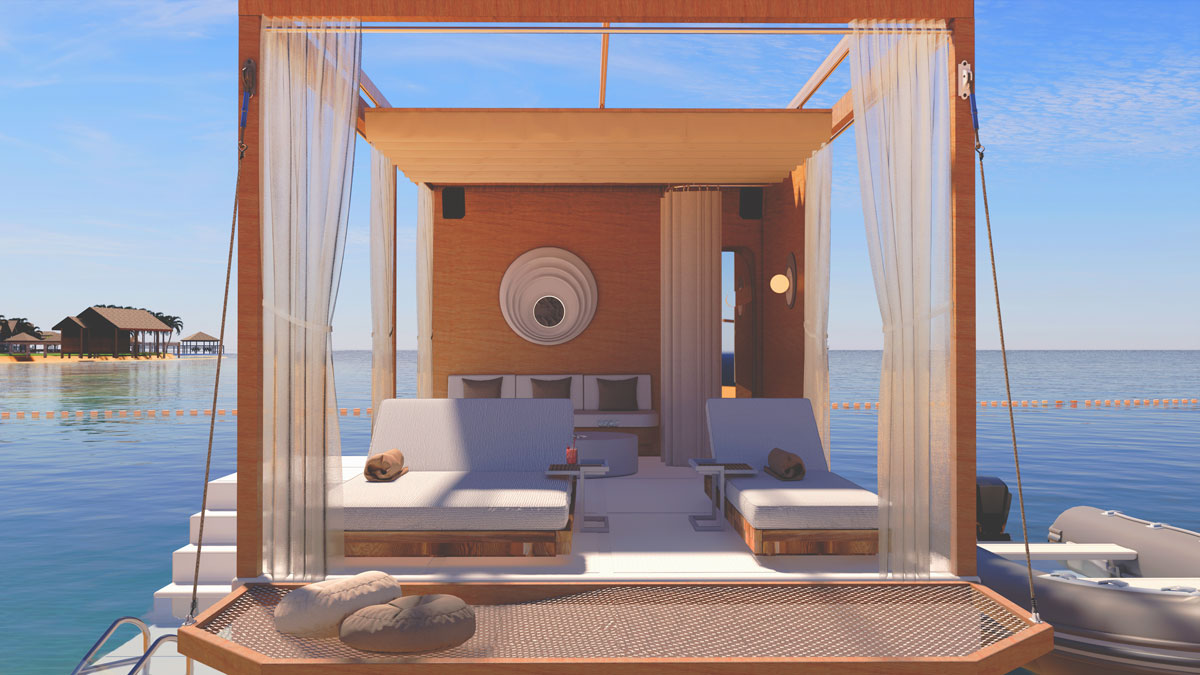
Beach holidays are no longer limited to the traditional trio of sea, sand, and sun. Today’s travelers crave unique experiences that blend relaxation with innovation. Enter the Floating Lounge, an innovative addition to waterfront properties [...]
Floating structures require mooring systems to remain stable on the water. Water level, tides, currents, etc. Many factors are what move any object on the water. Various mooring methods are used in order to be protected from these factors and to remain safe and stable on the water.

Mooring is the process of connecting a ship, boat, floating dock or floating structures to the seabed with the help of chains and ropes for controlled positioning on the water. This process ensures that the ship or floating structure remains stationary on the water. Mooring is necessary for many reasons; eg wind, wave, current, etc. It is used to prevent the ship or a floating structure from being thrown for reasons.

Basically, floating structures fixed to the waterbed or shoreline are structures that are fixed to the waterbed using different types of mooring and anchoring methods. Pontoons, like ships and boats, need mooring systems. Chains, steel or composite ropes are generally used for fastening.

Mooring types may vary according to the dimensions of the floating structure, tonnage, environmental conditions in the field operation area and bathymetric reports. Commonly used mooring methods are:
This type of mooring is anchoring at one point of the floating structure with a single chain (or steel or composite rope). Usually used for small boats or tugs.
This type of mooring is the fastening of the floating structure with chains (or steel or composite ropes) at more than one point. Multi-point lashing provides stable fixation of the floating structure and is usually the way of tying pontoons.
This type of mooring is the fastening of the floating structure with chains (or steel or composite rope) from more than one point. The chains are connected to the floating structure at a wide angle and resistance is gained against the direction of the force. It is often used for very large floating structures.
This type of mooring is the motion controlled fixation of the floating structure. This system; It is important to keep the position of the floating structure stable against waves, tides or currents. It is used on very large floating structures and large ships. It is often used for submarine research vessels or for eco-friendly alternatives in shipping.

Mooring calculations are made according to factors such as the dimensions of the floating structure, port conditions, the direction and intensities of the forces acting, and the wind and wave conditions. Various formulas can be used for these calculations.

Incorrect mooring or inadequate mooring equipment can cause ships or structures to deflect or move.
Mooring is vital for securing floating structures. This can increase the risk of collision with structures and cause damage.
The chain selection for the mooring system should be made according to factors such as the dimensions of the structure to be used, tonnage, design, operation area, force directions, waves, wind, currents and regulations. It is the most important element of the chain mooring system. It ensures the fixation of the floating structure and since it can be exposed to high forces, it should be selected to provide sufficient strength and durability.
Concrete sinker blocks are one of the most widely used anchoring types. Pre-prepared blocks of appropriate sizes are sometimes placed singly and sometimes more than once. On soft soils, their adhesion increases by sinking to the bottom over time. It should not be forgotten that it will lose 45% of its weight in water.
Generally used for permanent anchoring. It is called by this name because it resembles a mushroom in shape. In places where there are mud-sludge floors, it is thrown to the bottom and almost all of it is buried due to its weight over time. A fully buried cork anchor in this way provides a hold of approximately 10 times its own weight.
Dor-Mor anchor is a method that reaches the bottom of the water at high speed and is deeply embedded in the bottom. It has a holding power of approximately 10 times its weight. Due to its pyramid shape, it has an increasing suction effect as it is buried.
The screw arch anchoring system is an alternative method to the high-weight block anchoring method that provides secure and strong anchoring of floating structures. The screwing action on the seafloor keeps the anchor tight on the seafloor and prevents the structure from moving.
